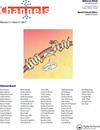GABAA亚基的顺行转运信号是功能表达所必需的
IF 3.2
3区 生物学
Q2 BIOCHEMISTRY & MOLECULAR BIOLOGY
引用次数: 0
摘要
五聚体GABAA受体由19个可能的亚基组成。GABAA β亚基是独特的,因为β1和β3亚基可以作为同聚体组装并运输到细胞表面,而大多数其他亚基,包括β2,都是异聚体。GABAA亚基的胞内结构域(ICD)与GABAA受体在质膜上的靶向和聚集有关。在这里,我们试图测试ICD是否以及如何参与β3亚基的功能表达。由于θ与β最同源,但不形成同源体,我们创建了两个相互嵌合的亚基,将ICD交换在β3和θ亚基之间,并在HEK293细胞中表达。免疫荧光法检测表面表达,快速灌注全细胞膜片钳记录功能表达。结果表明,与β3不同,β3/θ ic和θ/β3IC嵌合体在单独表达时均不能转运到质膜;然而,当与野生型α3或β3结合表达时,β3/θIC嵌合体都能得到功能性表达。这表明α3和β3的ICD都包含必要的逆行运输信号,这些信号是克服组装的GABAA同源或异聚体的内质网保留所必需的。本文章由计算机程序翻译,如有差异,请以英文原文为准。
Anterograde trafficking signals in GABAA subunits are required for functional expression
ABSTRACT Pentameric GABAA receptors are composed from 19 possible subunits. The GABAA β subunit is unique because the β1 and β3 subunits can assemble and traffic to the cell surface as homomers, whereas most of the other subunits, including β2, are heteromers. The intracellular domain (ICD) of the GABAA subunits has been implicated in targeting and clustering GABAA receptors at the plasma membrane. Here, we sought to test whether and how the ICD is involved in functional expression of the β3 subunit. Since θ is the most homologous to β but does not form homomers, we created two reciprocal chimeric subunits, swapping the ICD between the β3 and θ subunits, and expressed them in HEK293 cells. Surface expression was detected with immunofluorescence and functional expression was quantified using whole-cell patch-clamp recording with fast perfusion. Results indicate that, unlike β3, neither the β3/θIC nor the θ/β3IC chimera can traffic to the plasma membrane when expressed alone; however, when expressed in combination with either wild-type α3 or β3, the β3/θIC chimera was functionally expressed. This suggests that the ICD of α3 and β3 each contain essential anterograde trafficking signals that are required to overcome ER retention of assembled GABAA homo- or heteropentamers.
求助全文
通过发布文献求助,成功后即可免费获取论文全文。
去求助
来源期刊

Channels
生物-生化与分子生物学
CiteScore
5.90
自引率
0.00%
发文量
21
审稿时长
6-12 weeks
期刊介绍:
Channels is an open access journal for all aspects of ion channel research. The journal publishes high quality papers that shed new light on ion channel and ion transporter/exchanger function, structure, biophysics, pharmacology, and regulation in health and disease.
Channels welcomes interdisciplinary approaches that address ion channel physiology in areas such as neuroscience, cardiovascular sciences, cancer research, endocrinology, and gastroenterology. Our aim is to foster communication among the ion channel and transporter communities and facilitate the advancement of the field.
 求助内容:
求助内容: 应助结果提醒方式:
应助结果提醒方式:


